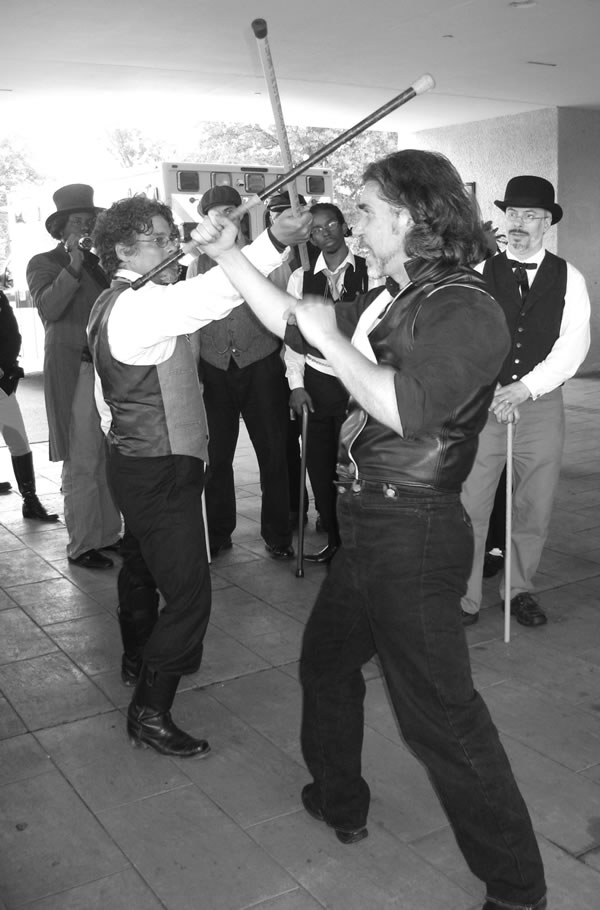BY SCOTT STIFFLER
Victorian defense secrets revealed to the cell phone generation
You know how it is. You long to stroll the waterfront, but deny yourself the simple pleasures of a cool summer breeze and a sunset vista — because as dusk approaches, you fear the unwanted advances of uncouth ruffians or militant suffragettes or aggressive newsies hawking tawdry tabloid headlines.
Armed with only a parasol (or umbrella or snuff box), a respectable lady or gentleman is utterly defenseless — unless of course, you’ve just emerged from Professor Mark Donnelly’s intense two-day seminar revealing the lost Victorian martial art known as “Bartitsu.”
You haven’t heard of Bartitsu? Oh, yeah, that’s right. It’s 2011…and you’re not a member of the newly minted leisure class who’s become immersed in 19th century England’s physical culture craze — which is your loss. Because like all crazes, Bartitsu burned brightly before that self-defense discipline’s dying ember wrought its ghost upon the floor. For over a century, the secrets and skills of Bartitsu (utterly applicable to our modern world) were lost, forgotten and otherwise ignored.
It didn’t help matters that Sir Arthur Conan Doyle (author of the Sherlock Holmes novels, and a notoriously poor fact checker) incorrectly name-dropped Bartitsu in “The Empty House.” Regarding a deadly showdown with his arch nemesis Professor Moriarty (atop the rushing waters of Reichenbach Falls), Holmes recalls,
We tottered together upon the brink of the fall. I have some knowledge, however, of baritsu, or the Japanese system of wrestling, which has more than once been very useful to me. I slipped through his grip, and he with a horrible scream kicked madly for a few seconds, and clawed the air with both his hands. But for all his efforts he could not get his balance, and over he went.
The elimination of a “t” (and the implication that Holmes’ deadly skill came solely from Japanese wrestling) sparked decades of debate as to the mysterious origins of “baritsu.” The truth, clarified by scholars in the mid-1980s, credits Bartitsu as the unique creation of a British engineer named Edward William Barton-Wright.
Having spent time in Japan studying Ju Jutsu, he returned to his beloved England and used that knowledge as the basis of a hybrid martial art form that became all the rage when Barton-Wright founded the Bartitsu Academy of Arms and Physical Culture in 1899 (at 67b Shaftesbury Avenue, in London’s Soho district). Just a few years later, his unique creation had fallen out of favor. Soon, it would fade into oblivion.
That’s where the New York Nineteenth Century Society comes into play. As an organization focused on uniting historians, scholars, artists, philosophers, dreamers and impresarios inspired by the 19th century, they have a vested interest in righting the wrong committed by Conan Doyle — and making Bartitsu relevant to our modern age.
That’s where Mark P. Donnelly, Professor di Armes comes in. On July 23 and 24, the society is hosting a Bartitsu seminar taught by Donnelly. A prolific author, screenwriter and television producer, you may have seen him adding some Victorian period cred to programs on the Discovery or History Channel. A recent phone conversation revealed Donnelly to be an articulate, polite and thoroughly charming gentleman firmly in possession of a subtle but sure confidence that comes with the ability to kick ass at will.
Of course, that would be rude if done without provocation — and herein lies the secret to the gentlemanly art of combat: knowing not just how, but when, to use it. So civilized; and yet, a fitting outlet for simmering rage. Perhaps that’s why Bartitsu had such appeal in its own time — and has been gaining favor among contemporary steampunks or bookish types who thrill to the adventures to Jules Verne or H.G. Wells.
Donnelly sees Bartitsu as a natural fit for fans of that era. “In the adventures of Allan Quartermain or ‘Twenty Thousand Leagues under the Sea,’ there’s danger; running, jumping and climbing. You’re up a cliff or racing down a river. It’s something you do physically, which I suppose helps to generate an interest in the martial culture as well. Whether you’re talking about Flash Gordon or Sherlock Holmes, things turn violent somewhere along the line.”
So when a scoundrel brings the fight to you, you’d better be ready. That urgent need for a physical response to unwanted confrontation is, Donnelly points out, one of the things that gave Bartitsu appeal — by empowering potential victims with the skills to fight back, using objects they were likely to have on hand.
“If you understand the principles of the system, any object can be turned to your advantage in a self-defense context,” explains Donnelly. “Look at the Victorian accessories. The walking stick, cane, umbrella, top hat, opera cape and snuff box are things they might have been carrying at the moment of attack. If you are holding an object, it either becomes an encumbrance or an asset.”
In modern times, the walking stick that occupied Victorian hands has been replaced with the cell phone or water bottle — both of which you’ll learn how to use as weapons of convenience when studying Neo-Bartitsu. That’s why the good professor carries a big bag of dummy cell phones to his seminars. “When somebody’s attacked on the street, it’s the electronics more so than the wallet they’re after. That glowing object in your hands is advertising its value and simultaneously distracting you from your surroundings. So you are limited to defending yourself with one hand or finding a way to use that to your advantage as a weapon.”
Donnelly emphasizes that he’s not out to breed a new generation of mixed martial artists prone to street fights in which fanny packs and bank cards are the weapons of choice. Most who attend his seminars, he says, are fans of physical expression as well as the intellectual culture of the time. “One of the attractive features of Bartitsu is that it was created for gentlemen and ladies — not athletes, not soldiers, not gymnasts. It’s for the average person of average physical ability, and it is designed to give them an intellectual advantage over their uneducated assailant. They outthink rather then outfight the attacker.” Asked to describe Bartitsu’s most famous practitioner, Donnelly says, “Sherlock Holmes is a gentleman badass. He’ll be remarkably polite. But the fact that you have gentility and manners doesn’t make you a pushover.”
































